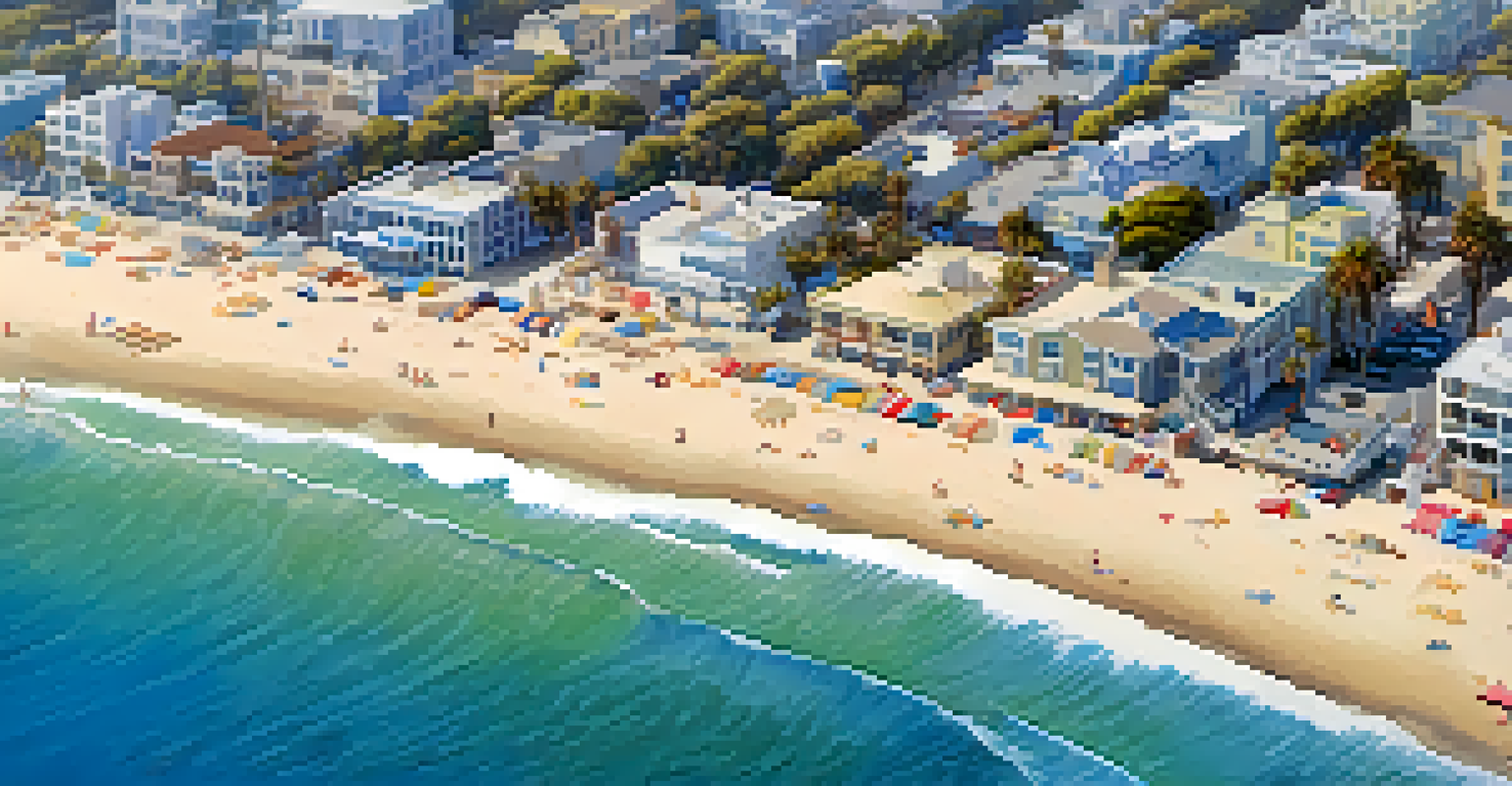The Role of Climate Change in Coastal Erosion in Santa Monica

What Is Coastal Erosion and Why Does It Matter?
Coastal erosion is the process where shorelines are worn away by natural forces such as waves, currents, and tides. It’s a naturally occurring phenomenon, but when accelerated by human activity and climate change, it poses significant threats to coastal communities. In Santa Monica, this erosion can lead to loss of land, damage to property, and a reduction in beach access, making it a critical issue for residents and visitors alike.
We won’t have a society if we destroy the environment.
When we think about coastal erosion, we often picture sandy beaches disappearing into the ocean. However, the impact reaches much further. Eroded coastlines can disrupt ecosystems, harm marine life, and even contribute to increased flooding and storm damage. This makes it essential for us to understand the factors contributing to this phenomenon, particularly in the context of climate change.
In a place as beautiful and iconic as Santa Monica, maintaining the coastline is not just about aesthetics; it’s about preserving the community's way of life. As we dive deeper into the role climate change plays in this process, we’ll uncover how rising sea levels and extreme weather events are reshaping our beaches.
The Connection Between Climate Change and Coastal Erosion
Climate change is fundamentally altering weather patterns and sea levels, both of which significantly impact coastal erosion. As temperatures rise, polar ice melts, causing oceans to swell and encroach on shorelines. For Santa Monica, this means that beaches, which once seemed stable, are now increasingly vulnerable to erosion, leading to a loss of valuable land.

In addition to rising sea levels, climate change brings about more intense storms and changing wave patterns. These storms can erode beaches much faster than usual, removing sand and altering the natural landscape. As these events become more frequent, the resilience of Santa Monica's coastline is put to the test, threatening not just the beach itself, but the businesses and homes nearby.
Coastal Erosion Threatens Communities
Coastal erosion, exacerbated by climate change, poses significant risks to Santa Monica's land, property, and beach access.
Understanding this connection is vital for local residents and policymakers alike. It highlights the need for proactive measures to combat erosion, such as beach replenishment and sustainable coastal management strategies, to protect Santa Monica’s shores for future generations.
Local Effects of Climate Change on Santa Monica's Beaches
Santa Monica's beaches serve as a crucial recreational area and economic driver for the community. However, the effects of climate change have begun to make their mark, with noticeable changes in beach width and sediment distribution. These shifts not only affect the natural beauty of the area but can also impact local businesses that rely on tourism and beachgoers.
The Earth does not belong to us: we belong to the Earth.
One of the most prominent effects is the increased frequency of beach erosion events during winter storms. These storms can wash away significant amounts of sand, leading to narrower beaches that are less inviting for visitors. Moreover, as the shoreline recedes, the risk of property damage increases, which raises insurance costs and can deter investment in coastal areas.
In response to these challenges, the local government has started initiatives aimed at mitigating erosion, including beach nourishment projects that replenish sand and restore lost beach areas. However, the ongoing battle against climate change means these solutions must be continually adapted and expanded to keep pace with the evolving landscape.
Community Responses to Coastal Erosion Challenges
The residents of Santa Monica have shown remarkable resilience in addressing the challenges posed by coastal erosion. Community forums and local organizations have sprung up, focusing on awareness and education about the impacts of climate change. This grassroots movement has fostered a sense of ownership among residents, leading to collective action aimed at preserving their beloved coastline.
Engagement efforts often include beach clean-ups, educational workshops, and advocacy for sustainable practices that protect the shoreline. By coming together, community members not only raise awareness but also implement practical solutions that can help mitigate the effects of erosion. This collaboration illustrates the power of community action in the face of climate change.
Climate Change Drives Coastal Erosion
Rising sea levels and intense storms linked to climate change are accelerating the erosion of Santa Monica's beaches.
Additionally, local artists and activists have used art and public installations to raise awareness about climate issues. These creative expressions not only beautify the area but also serve as poignant reminders of the urgent need to address coastal erosion and climate change collectively.
Innovative Coastal Management Strategies in Santa Monica
In light of the ongoing threats from climate change, Santa Monica has adopted innovative coastal management strategies to combat erosion. These strategies include a mix of soft and hard engineering solutions, such as the installation of sandbags, planting vegetation, and creating artificial reefs. Each of these methods aims to stabilize the shoreline while preserving its natural beauty.
One notable approach is the use of 'living shorelines,' which incorporate native plants and natural materials to create a buffer against waves and erosion. This method not only protects the coast but also enhances local biodiversity by providing habitat for various marine species. By embracing nature-based solutions, Santa Monica is setting an example for other coastal communities facing similar challenges.
Additionally, the city is investing in research and monitoring programs to better understand the impacts of climate change on coastal erosion. By gathering data and analyzing trends, Santa Monica can make informed decisions about future management strategies, ensuring that they remain effective in the long run.
The Importance of Public Policy in Addressing Erosion
Public policy plays a crucial role in shaping how Santa Monica responds to the challenges of coastal erosion. Effective policies can promote sustainable development, allocate resources for coastal protection, and ensure that the community is prepared for future climate impacts. Engaging with policymakers is essential for residents who want their voices heard in crucial environmental discussions.
One key area of focus for public policy is zoning regulations, which can help protect vulnerable areas from new developments that could exacerbate erosion. By creating buffer zones and limiting construction near the shoreline, policymakers can help maintain the integrity of Santa Monica's beaches. This proactive approach not only safeguards the environment but also protects property values in the area.
Community Action for Coastal Protection
Residents of Santa Monica are actively engaging in initiatives to raise awareness and implement solutions to combat coastal erosion.
Furthermore, collaborative efforts between local, state, and federal governments are vital for securing funding and support for coastal protection initiatives. As climate change continues to challenge coastal communities, strong public policies will be essential for ensuring a sustainable and resilient future for Santa Monica's coastline.
Looking Ahead: The Future of Santa Monica's Coastline
As we look to the future, the challenges posed by climate change and coastal erosion in Santa Monica will require ongoing vigilance and adaptation. The realities of rising sea levels and increased storm intensity mean that proactive measures will be more important than ever. The community's commitment to addressing these issues will play a pivotal role in shaping the future of its coastline.
Innovative technologies, coupled with community engagement, can drive the next wave of solutions aimed at combating erosion. For instance, advancements in coastal engineering and sustainable practices can enhance the effectiveness of existing strategies, ensuring that Santa Monica's beaches remain a cherished destination for years to come. The integration of local voices in these conversations is also vital, as they offer unique insights into the needs of the community.

Ultimately, the future of Santa Monica's coastline will depend on a combination of scientific research, public policy, and grassroots activism. By working together, residents, businesses, and local authorities can create a resilient and thriving coastal environment that honors both the natural beauty and the community's heritage.